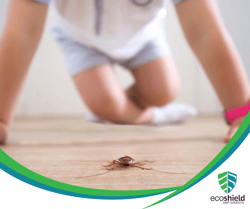If you're a homeowner, you may have encountered the unwelcome presence of cockroaches scuttling across your kitchen floor or lurking in the corners of your home. While their mere presence is unsettling, you may be curious whether these pests can take their intrusion to the next level and actually bite or sting you. We hope to shed light on the age-old question: Can cockroaches bite or sting, and should you be worried about these creepy crawlers causing you harm? Let's dive into the facts and dispel the myths surrounding cockroach behavior to help you better understand their potential risks in your home.
What are cockroaches?
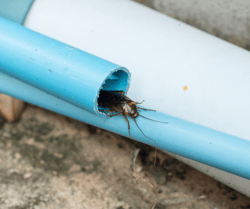 To better grasp the potential risk cockroaches pose to humans, it’s important first to understand the basics. Cockroaches, often referred to as nature's resilient survivors, are an extremely diverse group of insects belonging to the order Blattodea. These ancient insects have been around for millions of years, evolving and adapting to various environments across the globe. There are over 4,500 known species of cockroaches, but only a handful are commonly found in and around homes. Some of the most notorious species include the German cockroach, American cockroach, and Oriental cockroach.
To better grasp the potential risk cockroaches pose to humans, it’s important first to understand the basics. Cockroaches, often referred to as nature's resilient survivors, are an extremely diverse group of insects belonging to the order Blattodea. These ancient insects have been around for millions of years, evolving and adapting to various environments across the globe. There are over 4,500 known species of cockroaches, but only a handful are commonly found in and around homes. Some of the most notorious species include the German cockroach, American cockroach, and Oriental cockroach.
In appearance, cockroaches are recognized by their flattened, oval-shaped bodies and long, slender antennae. They typically have two pairs of wings, although not all species are capable of sustained and continuous flight. While cockroaches come in various colors and patterns, they often have a shiny, reddish-brown, or black exoskeleton. Their tough exoskeleton serves as both protection and a mechanism for retaining moisture, making them incredibly resilient to harsh conditions.
Cockroaches are notorious for their adaptability and expert survival skills. They are primarily nocturnal creatures, preferring to remain hidden during the day and emerging at night to search for food and water. As scavengers, roaches have a broad diet of feeding on a variety of organic matter, including food scraps, decaying matter, and even glue or paper. This omnivorous diet makes them highly adaptable and capable of thriving in a wide range of environments, from the sewers and basements of urban areas to the forests and grasslands of their natural habitats.
Despite their unsettling reputation, cockroaches serve ecological roles by aiding in the decomposition of organic material and providing food for other creatures. However, their presence in homes can often cause concern, as they are known vectors for various diseases and allergens. Additionally, the question of whether cockroaches can bite or sting remains a common query for homeowners, and understanding their behavior and potential risks is essential for effective pest management.
Why do roaches venture indoors?
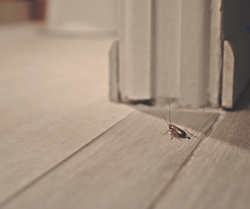 Cockroaches, despite their preference for natural outdoor environments, often venture indoors for a combination of survival-driven reasons. One primary factor is the pursuit of shelter. Cockroaches seek refuge from harsh weather conditions, extreme temperatures, and predators. During unfavorable conditions such as cold winters or scorching summers, they may find the controlled environment of our homes more hospitable. The cracks and crevices in walls, floors, and foundations provide convenient hiding places, while the warmth of indoor spaces can offer a comfortable haven for these insects.
Cockroaches, despite their preference for natural outdoor environments, often venture indoors for a combination of survival-driven reasons. One primary factor is the pursuit of shelter. Cockroaches seek refuge from harsh weather conditions, extreme temperatures, and predators. During unfavorable conditions such as cold winters or scorching summers, they may find the controlled environment of our homes more hospitable. The cracks and crevices in walls, floors, and foundations provide convenient hiding places, while the warmth of indoor spaces can offer a comfortable haven for these insects.
Another compelling factor driving cockroaches indoors is the promise of food and water. These resourceful creatures are opportunistic feeders, and they can detect even minute traces of organic matter. Kitchens and pantries, in particular, offer an abundant supply of food scraps, crumbs, and spilled liquids. Cockroaches are drawn to these easy food sources, making our homes an attractive destination. Additionally, they can survive for extended periods without food but require a source of water. Leaky pipes, condensation, and pet water bowls can provide the necessary moisture that keeps them hydrated.
Furthermore, cockroaches can inadvertently hitch a ride into our homes via various means. They may enter through gaps around doors and windows, hitch a ride on groceries, or even be brought in with used appliances or furniture. Once inside, their ability to reproduce quickly can lead to a population explosion, making eradicating them all the more challenging. In essence, while we may see cockroaches as unwanted intruders, they view our homes as a haven filled with the essentials for their survival: shelter, sustenance, and protection from the elements. Understanding their motivations for venturing indoors is key to preventing infestations and implementing effective pest control measures.
Can Roaches Harm Humans?
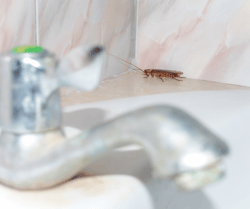 Cockroaches can indeed pose potential harm to humans, both directly and indirectly. While they are not typically aggressive insects and do not seek out humans as prey, they can still harm our health and well-being. One of the most significant concerns is the transmission of diseases. Cockroaches are known to carry and spread various pathogens, including bacteria, viruses, and parasites. They can pick up these harmful microorganisms from the unsanitary environments they inhabit, such as sewers, garbage, and decaying matter, and then transfer them to surfaces and food when they forage. As a result, cockroaches have been linked to the spread of illnesses like gastroenteritis, food poisoning, and allergies in humans.
Cockroaches can indeed pose potential harm to humans, both directly and indirectly. While they are not typically aggressive insects and do not seek out humans as prey, they can still harm our health and well-being. One of the most significant concerns is the transmission of diseases. Cockroaches are known to carry and spread various pathogens, including bacteria, viruses, and parasites. They can pick up these harmful microorganisms from the unsanitary environments they inhabit, such as sewers, garbage, and decaying matter, and then transfer them to surfaces and food when they forage. As a result, cockroaches have been linked to the spread of illnesses like gastroenteritis, food poisoning, and allergies in humans.
Another way cockroaches can harm humans is through the allergens they produce. These insects shed skin and leave behind droppings that contain proteins known to trigger allergic reactions and exacerbate asthma symptoms in susceptible individuals. The presence of cockroach allergens in indoor environments can lead to respiratory problems and worsen existing conditions, particularly in children and those with preexisting allergies or asthma.
Furthermore, cockroaches can indirectly harm humans by damaging property and contaminating food. They have a voracious appetite and can chew through various materials, including paper, cardboard, and even some fabrics. Their feeding habits can result in ruined possessions and costly repairs. Additionally, when they infest kitchens and food storage areas, they can contaminate food with their saliva, feces, and body parts, posing a risk to human health if consumed.
In summary, while cockroaches do not bite or sting humans as some other pests do, their potential for harm lies in their role as carriers of diseases, allergens, and their ability to contaminate our living spaces and food sources. Effective pest control and sanitation practices are essential for minimizing the risks associated with these unwanted houseguests.
How Can I Prevent Roaches in my home?
Luckily, homeowners can take several proactive steps to prevent cockroach infestations in their homes:
- Maintain cleanliness: Keep your home clean and free of crumbs, food residues, and standing water. Cockroaches are attracted to food sources, so regular cleaning of kitchen surfaces, floors, and food storage areas is crucial.
- Store food properly: Keep food items sealed in airtight containers and store them off the floor and away from walls. This makes it harder for cockroaches to access your food.
- Fix leaks and eliminate moisture: Cockroaches need water to survive, so fix any leaks promptly. Ensure that sinks, faucets, and pipes are not providing a water source for these pests.
- Seal entry points: Inspect your home for gaps or cracks in walls, floors, doors, and windows. Seal any openings with caulk or weatherstripping to prevent cockroaches from entering.
- Keep a clutter-free home: Clutter provides hiding places for cockroaches. Regularly declutter and organize your living spaces, reducing potential hiding spots.
- Dispose of trash properly: Use trash cans with tight-fitting lids and empty them regularly. Don't leave garbage bags lying around inside or outside your home.
- Remove potential hiding spots: Cockroaches often hide in cardboard boxes, newspapers, and piles of clutter. Discard or recycle these items to minimize hiding places.
- Clean pet dishes: Remove and clean pet food and water dishes after your pets have finished eating. Don't leave them out overnight.
- Maintain outdoor areas: Keep your yard and outdoor areas clean. Cockroaches can also thrive outdoors and may migrate indoors if conditions are suitable.
- Use screens and door sweeps: Install screens on windows and doors, and use door sweeps to prevent cockroaches from entering your home through gaps around doors.
- Regular inspections: Periodically inspect your home for signs of cockroaches, such as droppings, egg capsules, or a musty odor. Early detection can help prevent a small problem from becoming a full-blown infestation.
- Implement preventive measures: Consider using cockroach baits, traps, or insect repellents in areas where cockroaches are likely to enter or hide. Follow the manufacturer's instructions for safe and effective use.
If you suspect a cockroach infestation despite your preventive efforts, it's essential to address it promptly. In severe cases, consulting a professional pest control service may be necessary to effectively eliminate the problem. Regular maintenance and vigilance are key to keeping cockroaches at bay and maintaining a cockroach-free home.
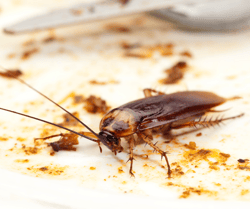
Can EcoShield help prevent or remove roaches?
Yes. EcoShield's comprehensive Shield Home Protection Plan offers all season protection against a variety of pests, including cockroaches. However, removing a cockroach infestation from your home can be lengthy to ensure the insects are fully eradicated. It also includes an equal commitment from both your pest professional and you as the homeowner. It's nearly impossible to exterminate every adult roach in a single service due to their ability to hide within walls and other unreachable areas. To address this, EcoShield also targets eggs that may be out of sight at the moment but could soon result in another wave of roach invaders after the eggs reach maturity. Still, EcoShield addresses potential entry points where the roaches may have gained entry.
Customers should be aware that if they don't adhere to the necessary sanitation plan EcoShield recommends, it's likely the roaches will return. This is why permanent roach eradication is very much a collaborative process between EcoShield and the customer. Our goal is to not only successfully get rid of your current cockroach infestation, but also prevent any future infestations.
If you’re currently experiencing a roach infestation in your home, contact EcoShield immediately for a free no, no-obligation quote. With EcoShield’s Home Protection Plan, we not only remove the existing cockroach infestation, but we also disrupt the roach lifecycle and address target locations in your home to prevent future infestations. This service protects you not only from cockroaches but a multitude of other creepy crawlies that frequently enter homes.
Call us today or fill out the form on this page to be connected with our trusted pest professionals.
